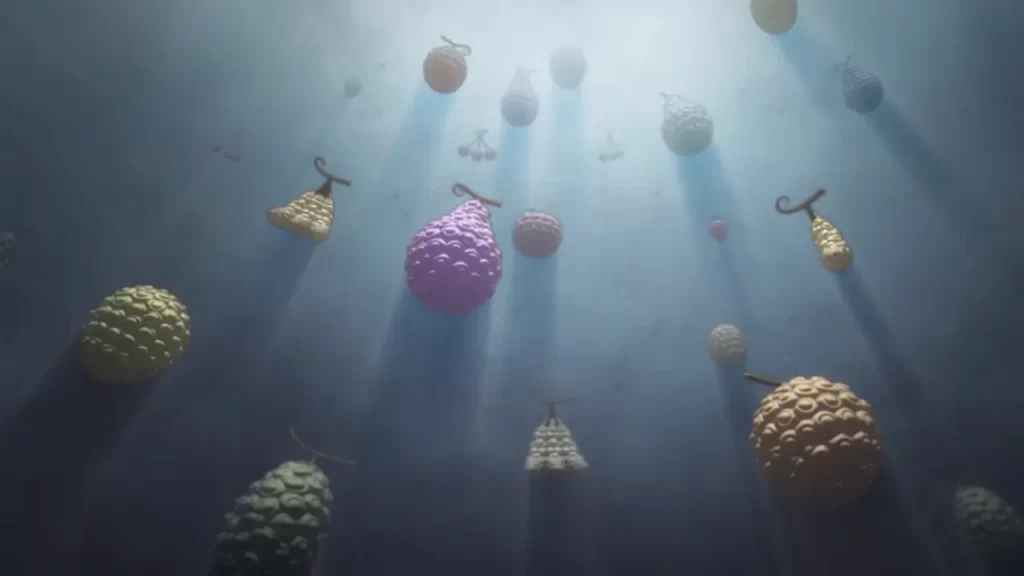
In the boundless seas of One Piece, power doesn’t just come from strength or swords. It often comes from mysterious fruits that defy the laws of nature. Enter the Devil Fruits: mystical, one-of-a-kind items that grant their eater superhuman abilities in exchange for a critical weakness, like the inability to swim.
Whether it’s turning into fire, stretching like rubber, or transforming into mythical creatures, the range of powers is astonishing.
Devil Fruits are the foundation of One Piece’s power system and are key to understanding its world.
In this guide, we’ll explore everything you need to know: what Devil Fruits are, how they work, their various types, and their hidden origins.
What Is a Devil Fruit in One Piece?
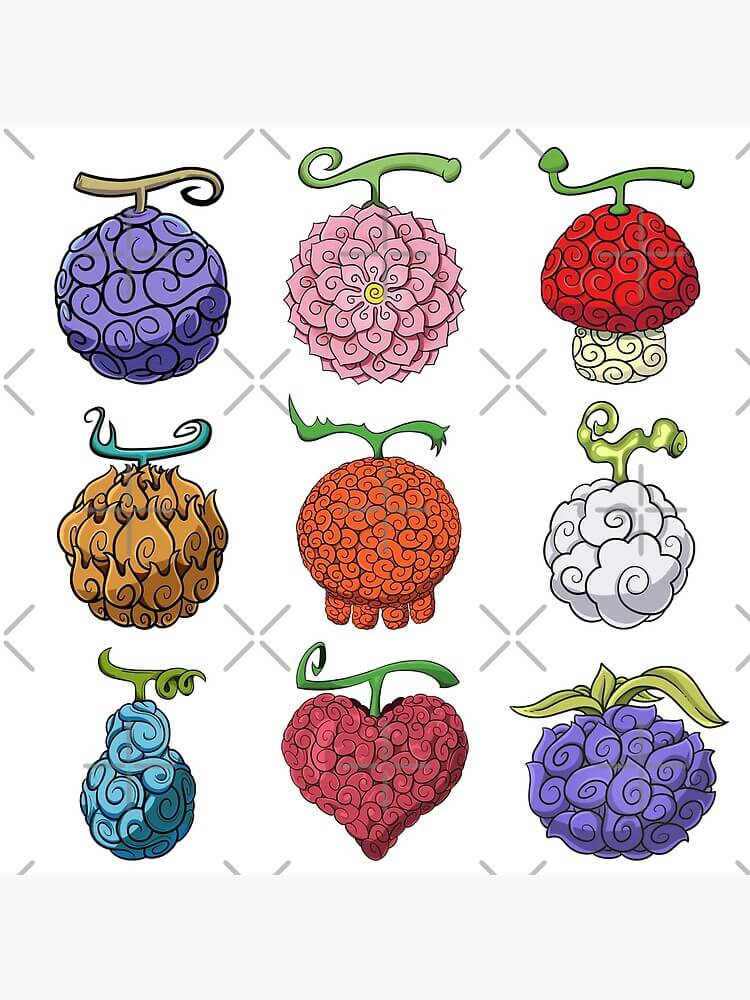
A Devil Fruit is a mysterious fruit that grants a person supernatural abilities when consumed. In exchange, the user permanently loses the ability to swim. Each Devil Fruit is unique, and no two exist at the same time. These fruits are considered one of the most defining power systems in the One Piece world and are linked to key figures across the Grand Line.
How Do Devil Fruits Work?
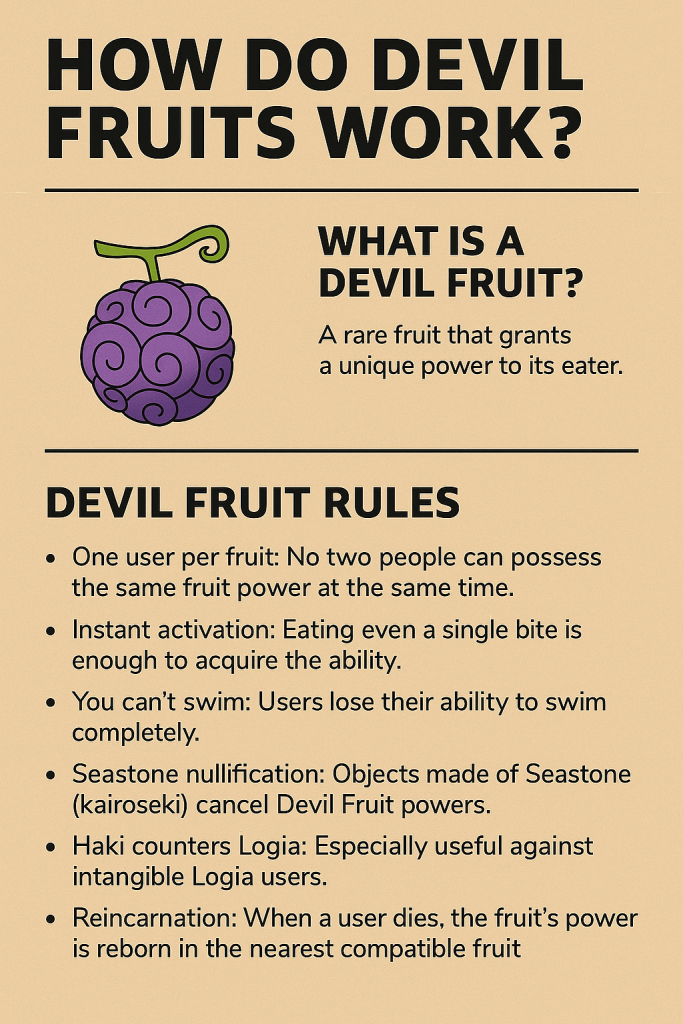
Once someone takes a single bite of a Devil Fruit, their DNA (known as the Lineage Factor) is altered, granting them the fruit’s ability. After consumption:
- The fruit becomes normal and useless to others.
- The user can never swim again.
- If they die, their power reappears in a nearby fruit.
- Seastone and Haki can counteract these powers.
Devil Fruit Rules
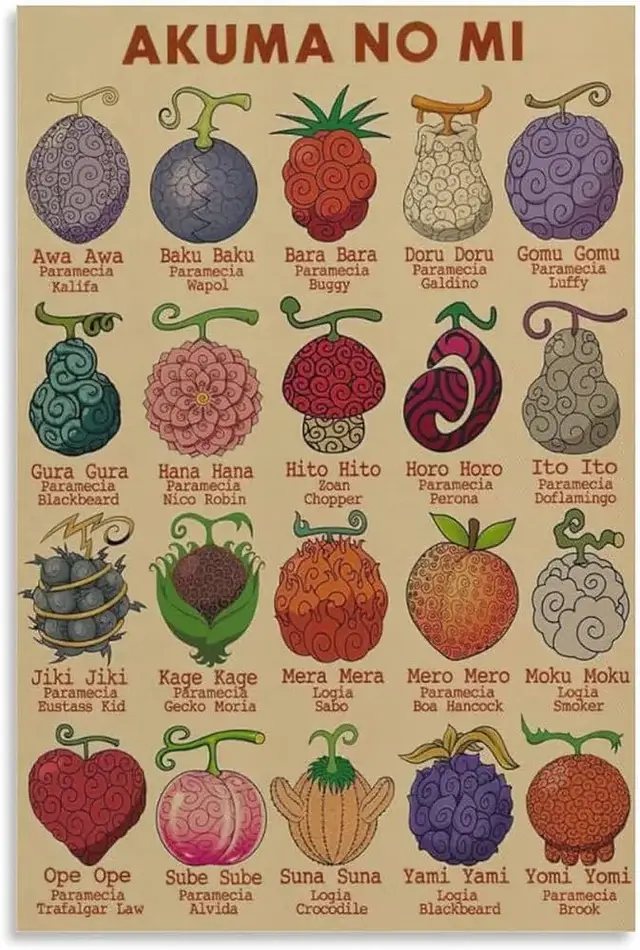
- One person per fruit at a time
- Bite = instant power
- No swimming forever
- Seastone disables its powers
- The Power reincarnates after death of the Devil Fruit user
- Haki can hurt Logia and bypass intangibility
Origin of Devil Fruits in One Piece

Dr. Vegapunk reveals that Devil Fruits may be born from human dreams, the desire to be something more. When these wishes take form, a fruit embodies them. The result is a unique power linked to human will.
This origin theory supports the mystical, almost divine nature of certain Mythical Zoans and Special Paramecia.
First Time Devil Fruit Was Shown in the Anime
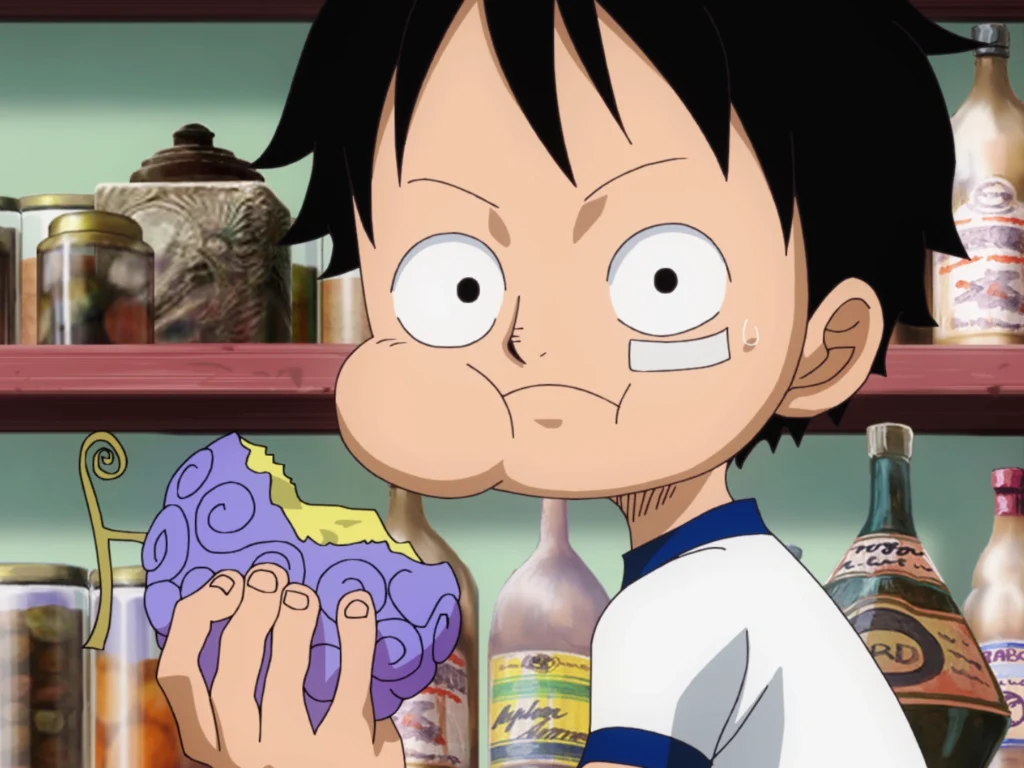
The first Devil Fruit appears in Episode 1, when we see Shanks save Luffy. Shortly after, Luffy eats the Gomu Gomu no Mi (later revealed as the Hito Hito no Mi, Model: Nika).
His rubber body powers are revealed in Episode 2 of the anime.
Who Is the First Devil Fruit User in One Piece?

The first user revealed in the series is Monkey D. Luffy.
But the first to use their powers on-screen is arguably Buggy the Clown, a Baroque Works agent who splits his body apart thanks to the Bara Bara no Mi.
Historically, the earliest known users in-world may be figures like Imu (if confirmed), Rocks D. Xebec, or early Marines.
Devil Fruits Appearance in One Piece
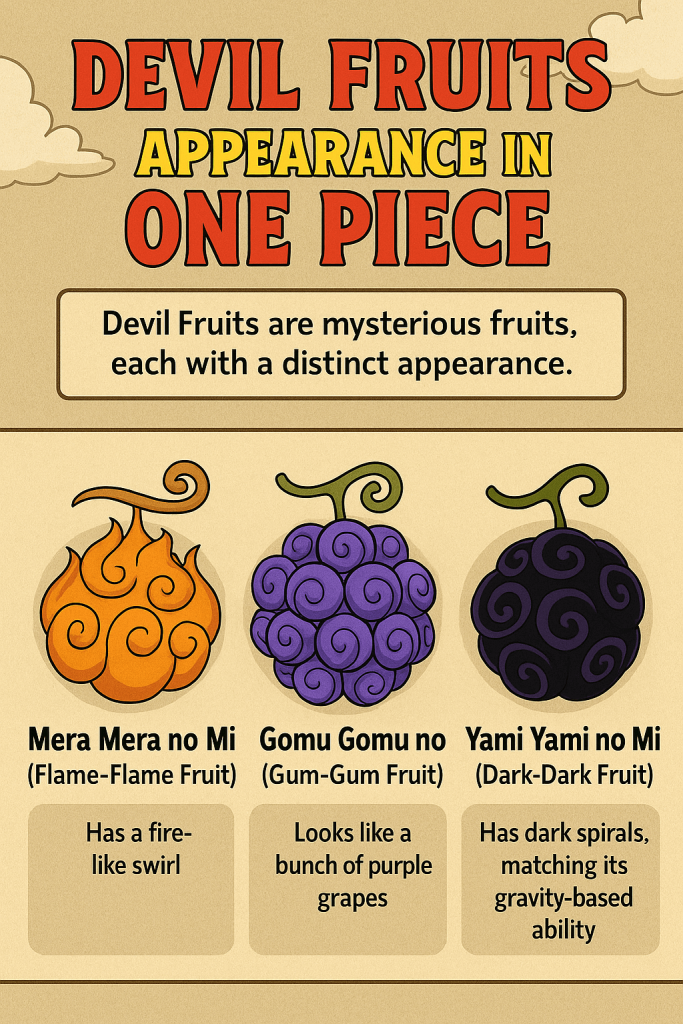
Devil Fruits have swirly patterns, often strange shapes, and vibrant colors. Each fruit is unique, and its outer design sometimes hints at its ability. Examples:
- Mera Mera no Mi (flame fruit) has a fire-like swirl
- Gomu Gomu no Mi looks like a bunch of purple grapes
- Yami Yami no Mi has dark spirals, matching its gravity-based ability
Types of Devil Fruits in One Piece
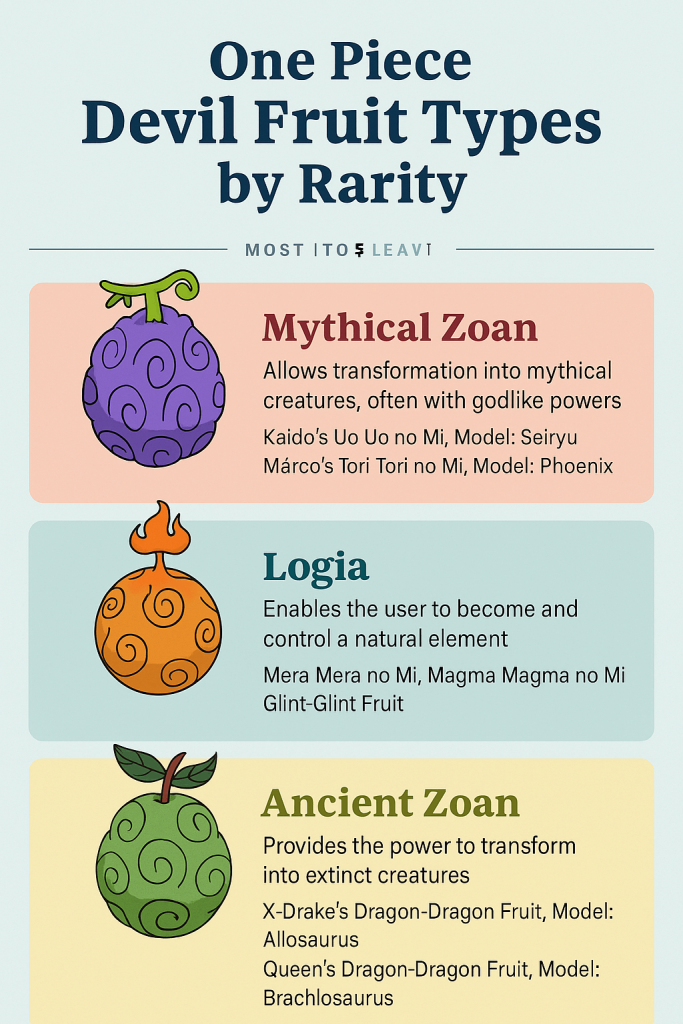
There are three main types of Devil Fruits:
- Zoan: Transformation-based; allows the user to become an animal or hybrid
- Paramecia: Most common; grants body modification, substance creation, or environment alteration
- Logia: Elemental powers; allows intangibility and control over nature
Zoan Devil Fruits
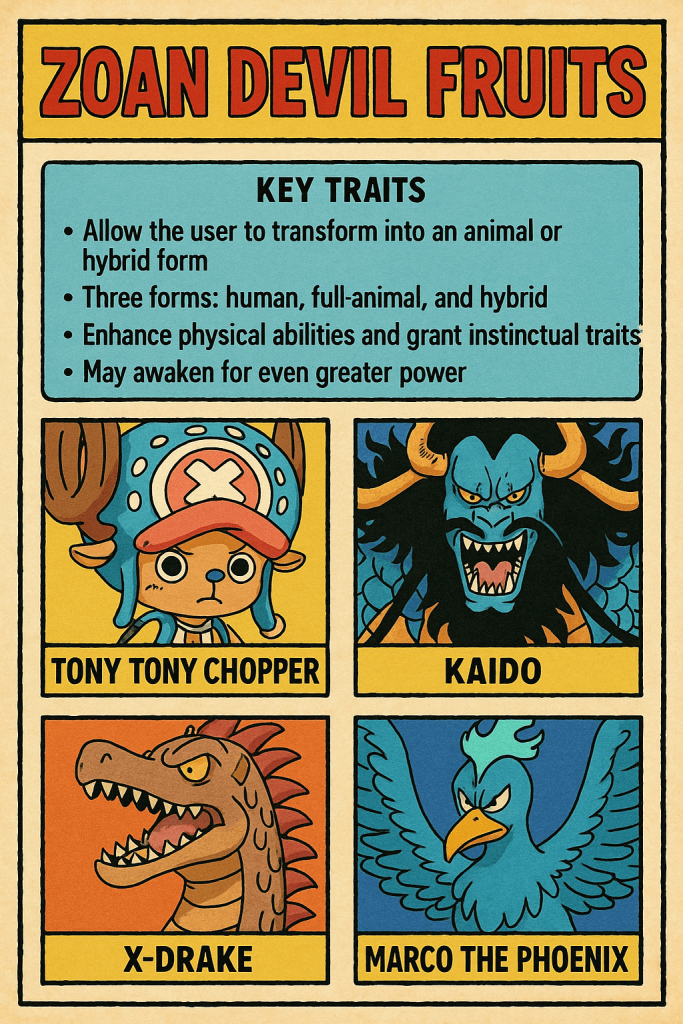
Zoan Devil Fruits are a type of Devil Fruit that allows the user to transform into a specific animal, a hybrid form, or the animal’s complete form.
Unlike Paramecia, which focuses on unique abilities, Zoan fruits specialize in physical transformation and power enhancement. They are especially useful for hand-to-hand combat, granting the user the physical traits and abilities of the chosen animal.
How Do Zoan Devil Fruits Work?
When a person consumes a Zoan Devil Fruit, they gain the ability to switch between three primary forms:
- Human Form: The user’s natural, unchanged form.
- Animal Form: A complete transformation into a specific animal.
- Hybrid Form: A combination of both human and animal traits, often enhancing physical power.
Zoan fruits can further be divided into specialized categories:
- Carnivorous Zoan: Animals with natural predatory instincts (e.g., leopards, wolves). These types are especially suited for combat.
- Example: Rob Lucci – Neko Neko no Mi, Model: Leopard
- Ancient Zoan: Extinct, prehistoric creatures like dinosaurs or mammoths. These forms are significantly more powerful and durable.
- Example: X-Drake – Ryu Ryu no Mi, Model: Allosaurus
- Mythical Zoan: The rarest and most powerful Zoan fruits, granting abilities based on mythical creatures, gods, or deities. These forms often exhibit special abilities beyond standard Zoan capabilities.
- Example: Kaido – Uo Uo no Mi, Model: Seiryu
- Artificial Zoan (SMILE): Man-made fruits that mimic Zoan abilities but with unpredictable and often dangerous side effects.
- Example: SMILE Users – Gifters in Kaido’s crew
Strengths and Weaknesses of Zoan Fruits:
Strengths:
- Enhanced physical strength and combat abilities.
- Potential for Awakening, further boosting endurance and recovery speed.
- Mythical Zoans often come with special abilities beyond simple transformation.
Weaknesses:
- Users remain tangible and can be hit directly.
- Carnivorous and Ancient Zoans can be reckless and difficult to control.
- Artificial Zoans (SMILE) have unpredictable side effects.
Zoan fruits are known for their transformation abilities.
Subtypes:
- Carnivorous (aggressive animals)
- Ancient (dinosaurs, mammoths)
- Mythical (phoenix, dragon, Nika)
- Artificial (SMILE fruits, man-made Zoans)
Notable users: Chopper, Kaido, Marco, Lucci
Logia Devil Fruits
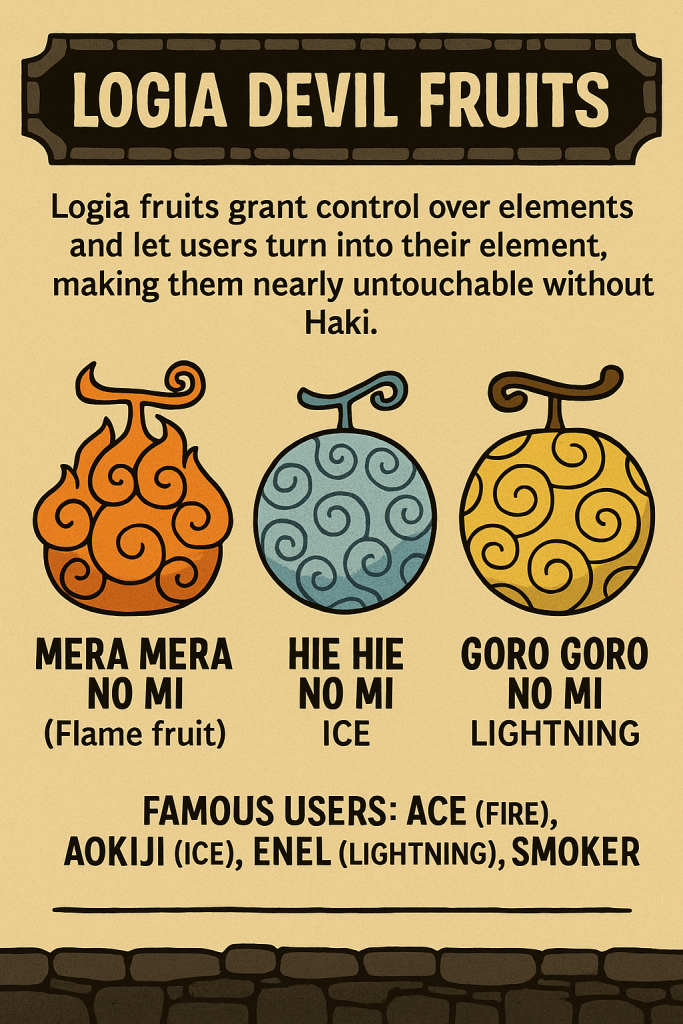
Logia Devil Fruits are the rarest and most powerful class of Devil Fruits, allowing the user to transform into, generate, and control a natural element or force of nature. Unlike other fruits, Logia users can become intangible, making them nearly invincible without the use of Haki or special abilities.
How Do Logia Devil Fruits Work?
Upon consuming a Logia Devil Fruit, the user gains the ability to transform their body into a specific element and control it at will. They can also produce the element indefinitely and manipulate it for both offensive and defensive purposes.
Examples of Logia elements include:
- Fire (Flame): Mera Mera no Mi – User can turn into and control fire (Ace, Sabo)
- Ice: Hie Hie no Mi – User can become and control ice (Aokiji)
- Lightning: Goro Goro no Mi – User can turn into and manipulate lightning (Enel)
- Smoke: Moku Moku no Mi – User can produce and become smoke (Smoker)
- Darkness: Yami Yami no Mi – User can control darkness and gravity (Blackbeard)
Notable Logia Users and Their Fruits:
- Ace / Sabo: Mera Mera no Mi (Flame)
- Aokiji: Hie Hie no Mi (Ice)
- Enel: Goro Goro no Mi (Lightning)
- Smoker: Moku Moku no Mi (Smoke)
- Blackbeard: Yami Yami no Mi (Darkness and Gravity)
Strengths and Weaknesses of Logia Fruits:
Strengths:
- Complete intangibility; attacks pass through the user.
- Elemental control and manipulation at will.
- Ability to absorb, disperse, or counter attacks using the element.
- Some Logia fruits have unique properties (e.g., darkness can absorb attacks).
Weaknesses:
- Haki can bypass intangibility, making the user vulnerable.
- Elements can be countered by natural opposites (e.g., ice vs. fire).
- Overreliance on intangibility can lead to complacency in physical combat.
- The Yami Yami no Mi is the only Logia that does not grant intangibility; instead, it absorbs attacks.
Paramecia Devil Fruits
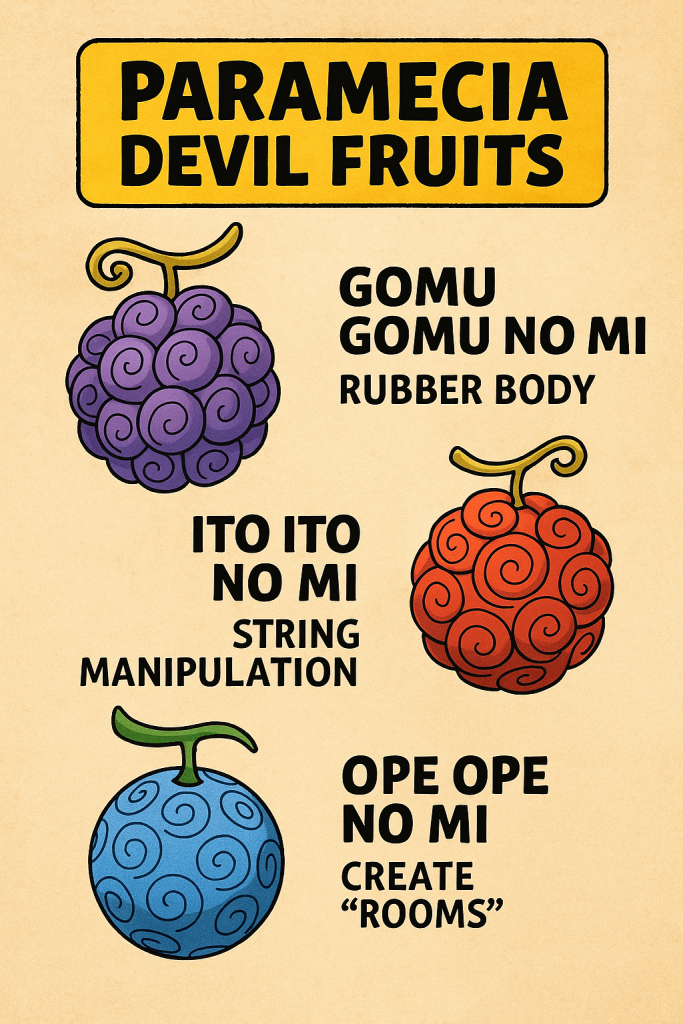
Paramecia Devil Fruits are one of the three main types of Devil Fruits in the One Piece world. These fruits grant the user superhuman abilities that can affect their body, create substances, or manipulate their surroundings in various ways. Unlike Zoan fruits, which focus on animal transformations, and Logia fruits, which allow the user to transform into elements, Paramecia fruits provide abilities that are typically not elemental or animal-based.
How Do Paramecia Devil Fruits Work?
When a person consumes a Paramecia Devil Fruit, they gain a unique power that can either alter their body, generate specific substances, or exert a specific influence on the environment around them. However, they still retain their physical form rather than becoming a full-fledged element or creature.
Paramecia fruits can be categorized into three broad subtypes:
- Body-Altering Paramecia: These fruits modify the user’s body, granting them new physical properties or abilities.
- Example: Gomu Gomu no Mi (Rubber Fruit) – Luffy’s body becomes as stretchy and durable as rubber.
- Substance-Generating Paramecia: These fruits allow the user to produce or control certain substances.
- Example: Doru Doru no Mi (Wax Fruit) – Mr. 3 can produce and manipulate wax.
- Environmental Manipulation Paramecia: These fruits enable the user to alter the environment or manipulate external objects in unique ways.
- Example: Ope Ope no Mi (Operation Fruit) – Law can create “Rooms” where he can perform surgical-like operations on anything inside.
Strengths and Weaknesses of Paramecia Fruits:
Strengths:
- Highly versatile; abilities can range from physical enhancements to environmental manipulation.
- Often unpredictable, they are harder for opponents to counter.
- Some can function similarly to Logia fruits, such as Katakuri’s Mochi ability.
Weaknesses:
- Users remain physically solid and can be hit directly.
- Less intangibility and invincibility compared to Logia fruits.
- Haki can effectively counter most Paramecia abilities.
These fruits grant users a wide range of abilities:
- Altering the body (Luffy’s rubber)
- Manipulating surroundings (Doflamingo’s strings)
- Generating substances (Mr. 3’s wax, Magellan’s poison)
Special Paramecia (e.g., Katakuri’s mochi) blur the line with Logia.
Total Number of Devil Fruits in One Piece
There’s no official count, but Oda has implied that over 100 unique fruits exist in the world. With Vegapunk’s research and the discovery of SMILEs, the number may be higher, including artificially created or replicated fruits.
Awakening of Devil Fruits in One Piece
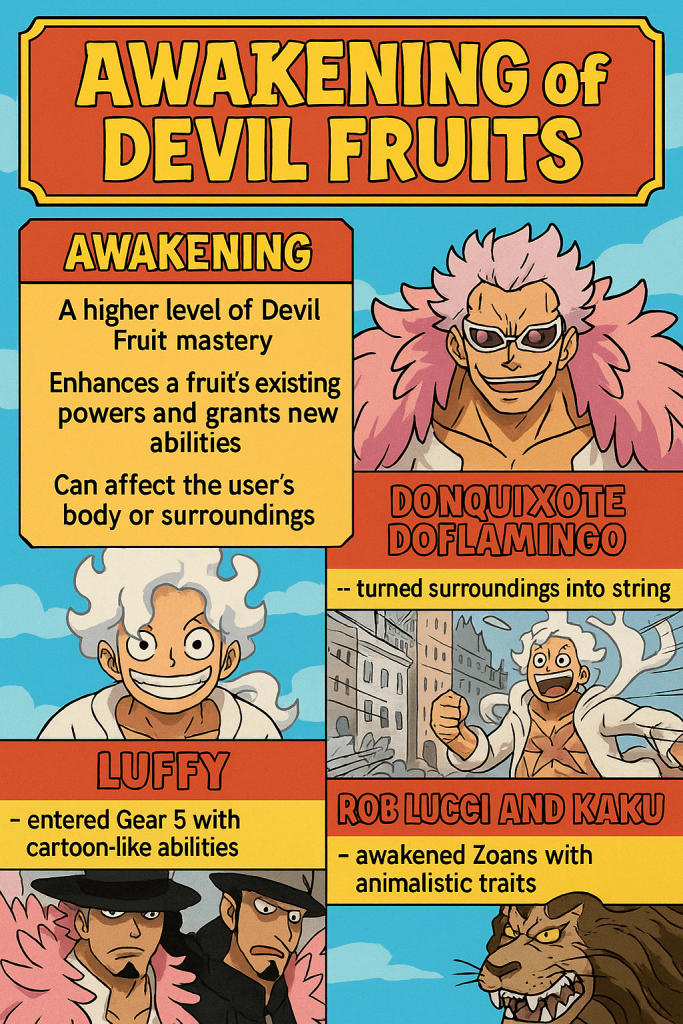
Awakening is the advanced state of a Devil Fruit where the user gains mastery over their powers to a level that extends beyond the typical abilities granted by the fruit.
Upon awakening, the user can manipulate not only their own body but also the environment around them, drastically amplifying their powers.
Awakening enhances the core ability of a fruit, often affecting the surroundings or drastically increasing power.
Types of Awakening and Effects:
1. Paramecia Awakening:
When a Paramecia user awakens their fruit, they gain the ability to affect their surroundings with the properties of their fruit rather than just their body.
- Example:
- Donquixote Doflamingo (Ito Ito no Mi – String-String Fruit): Doflamingo can turn nearby surfaces into strings, using them for large-scale attacks like the Birdcage.
- Eustass Kid (Jiki Jiki no Mi – Magnetism Fruit): After awakening, Kid can magnetize surrounding metal objects to form massive weapons.
- Effect: The awakened user can alter the terrain, convert nearby materials to their fruit’s properties, and extend their power’s reach significantly.
2. Zoan Awakening:
Zoan awakenings differ in that they greatly enhance the physical abilities of the user, granting them increased durability, recovery, and strength.
- Example:
- Jailer Beasts (Unnamed Zoan Fruits): The Impel Down guards exhibit monstrous strength, rapid healing, and extreme durability.
- Rob Lucci (Neko Neko no Mi, Model: Leopard): Enhanced physical power and recovery speed after awakening.
- Effect: The user becomes a near-perfect combat machine, with abilities resembling those of a fully awakened animal form. Some Mythical Zoan awakenings can also grant unique abilities beyond physical transformation, such as Luffy’s Nika form.
3. Mythical Zoan Awakening:
Mythical Zoan fruits are the rarest and most powerful form of Zoans. When awakened, they provide not only enhanced physical traits but also unique abilities tied to the mythical creature’s lore.
- Example:
- Luffy (Hito Hito no Mi, Model: Nika): Upon awakening, Luffy gains cartoon-like abilities that allow him to stretch, compress, and even alter reality in ways that defy logic.
- Marco the Phoenix (Tori Tori no Mi, Model: Phoenix): Marco can heal himself and others with blue flames, a power tied to the myth of the phoenix’s regenerative abilities.
- Effect: Reality-warping abilities, heightened physical capabilities, and special powers that align with the mythical creature’s legend.
How Does Awakening Occur?
Awakening is not easily achieved. It requires intense training, mastery of the fruit, and potentially a life-threatening situation to trigger the full extent of the Devil Fruit’s power.
In most cases, users are unaware of the awakening’s existence until they reach a critical point in their development or during a climactic battle.
Strengths of Awakening:
- Greatly enhanced abilities and control
- Potential to manipulate the environment (Paramecia)
- Increased durability and stamina (Zoan)
- Reality-altering powers (Mythical Zoan)
Weaknesses of Awakening:
Vulnerable to Haki, especially against Logia and Paramecia users
Confirmed awakened users:
Physically exhausting and mentally taxing
Can be unstable and unpredictable
Awakening requires mastery and focus; lack of control can backfire
- Doflamingo (strings)
- Law & Kid (environmental manipulation)
- Luffy (cartoon physics with Nika)
- Zoan awakenings: Lucci, Kaku, Jailer Beasts
Popular Devil Fruits and Their Users
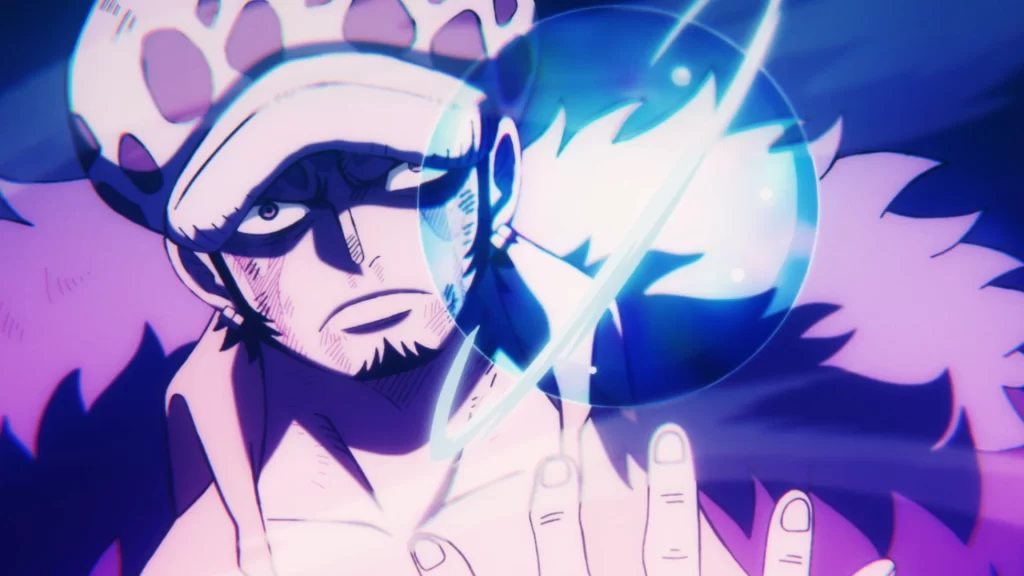
- Luffy – Hito Hito no Mi, Model: Nika (Mythical Zoan)
- Blackbeard – Yami Yami no Mi + Gura Gura no Mi
- Ace/Sabo – Mera Mera no Mi
- Law – Ope Ope no Mi
- Kaido – Uo Uo no Mi, Model: Seiryu
- Enel – Goro Goro no Mi
- Marco – Tori Tori no Mi, Model: Phoenix
- Doflamingo – Ito Ito no Mi
FAQ Section
How do Devil Fruits work in One Piece?
Devil Fruits alter a person’s biology to grant abilities at the cost of swimming. Each fruit is unique, and upon death, its power transfers to another fruit.
Have Devil Fruits been explained?
Yes, Vegapunk confirmed they come from human desires and dreams, with their powers passed via the Lineage Factor.
What are Paramecia and Logia?
Paramecia alters the body or surroundings; Logia grants elemental control and intangibility. Both differ in range and counter-strategies.
Is Luffy a Zoan or a Paramecia?
Luffy is a Mythical Zoan user. Hito Hito no Mi, Model: Nika, not Paramecia as originally believed.
Does Zoro eat a Devil Fruit?
No—Zoro uses swordsmanship and Haki. He relies on raw physical power and training.
What is the rarest Devil Fruit?
Mythical Zoan fruits are considered the rarest. Examples include Kaido’s Uo Uo no Mi, Model: Seiryu and Marco’s Tori Tori no Mi, Model: Phoenix.



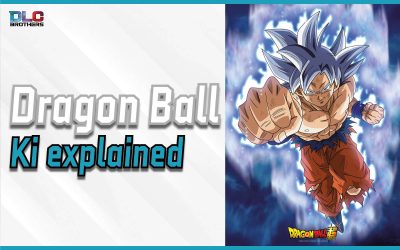
0 Comments